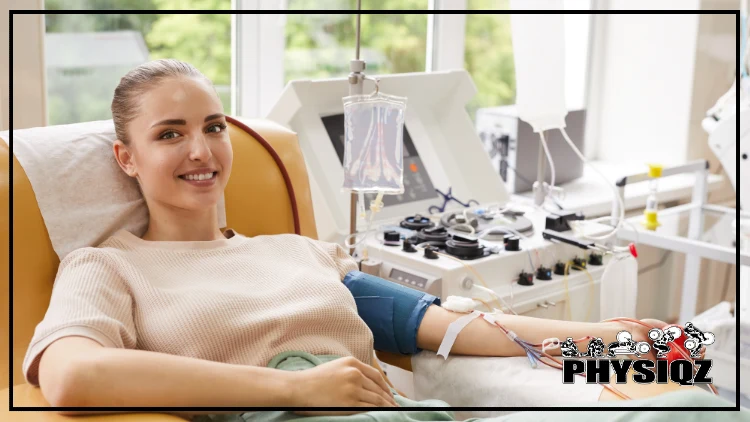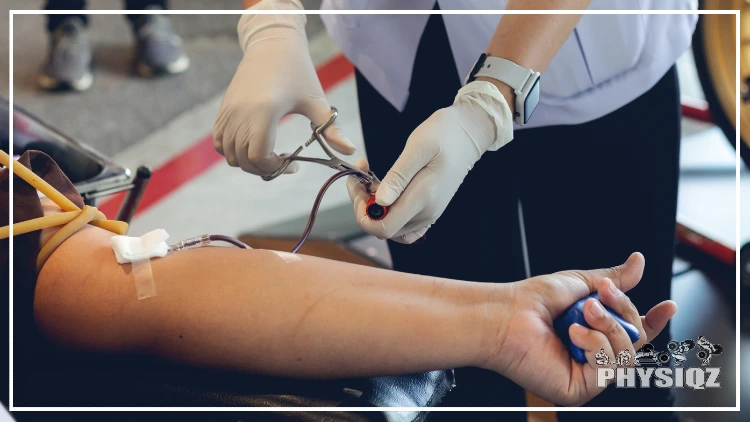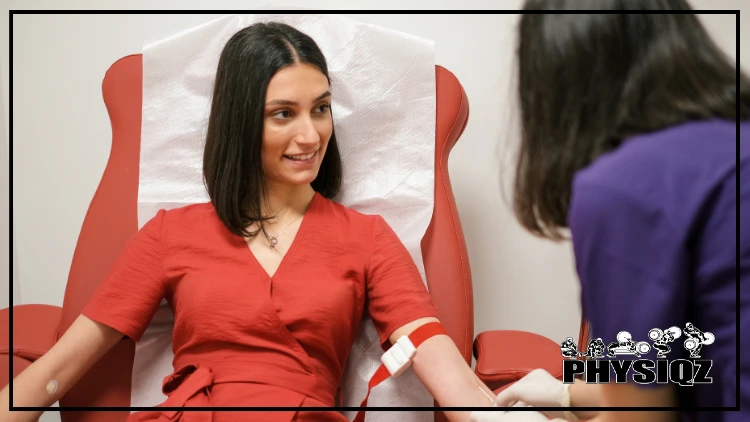
Table of Contents
Does donating plasma affect muscle growth?9
While there may not be a direct correlation between donating plasma and subsequent muscle growth, there is an indirect affect since the following workouts may be impaired due to dehydration, fatigue, loss of protein (more on this below), sugars and potential discomfort — and this is exactly why you should be careful.
So if you intend to donate plasma or already have, be sure to follow the post plasma donation protocol below to understand the best way to recover from plasma donation in order to get back into the gym as soon as possible and more importantly, get back to lifting safely.
Does Donating Plasma Affect Muscle Growth?
Donating plasma can hurt someone’s workout and short term gains and there may be a domino effect to a gym goer’s powerlifting programs or bodybuilding workout plans. However, in the long term, there is no evidence to support that it negatively impacts hypertrophy (muscle growth) or the body’s ability to repair muscle damage after strength training.

Source: ภาพของMemorystockphoto via Canva.com10
Donating plasma has a negative impact on exercise performance as a result of decreased anaerobic capacity and blood donation itself affects strength training due to lower oxygen levels in the blood.1 This will obviously have an indirect impact on muscle growth because training will be hindered since not enough training volume and intensity can be applied to the regimen due to tiring quickly thus extracting a poor workout.
Does donating plasma affect muscle growth? No, however when someone donates plasma, their energy levels are temporarily vastly reduced and there is an increased amount of fatigue for a period of 24-48 hours after donation.
It is therefore recommended to schedule a plasma donation before taking a rest day (or a few) from the regimen to allow plasma regeneration.
Failure to do this can place the lifter at risk for fainting and subsequent injury.
How the Side Effects of Donating Plasma Affects Subsequent Workouts
As lightly touched on before, donating plasma has some side effects which will make workouts inefficient and these include dehydration, loss of proteins and sugars contained in plasma which induce fatigue and other symptoms. The detailed list appears below.
Dehydration
The plasma in blood has a high amount of water. Plasma is water based and is a type of netting that contains and carries within it the components of blood: proteins, platelets, red and white blood cells.
Therefore, it is common for some people to become dehydrated after donating plasma which can result in them feeling lightheaded which is not conducive to engage in strength training.
Loss of Proteins & Sugars
Plasma contains a significant amount of nutrients including proteins, sugars and salts. These are vital in keeping the body in an alert state and functioning optimally.
Loss of these substances will typically cause an electrolyte imbalance which may make someone feel dizzy and fainting.
This will render a visit to the gym likely intolerable. It should be noted that the proteins present in plasma do not play a role in muscle growth per se as they are not part of the amino acids that do so, this is discussed in the sections to follow.
Makes People Tired & Fatigued
Due to the loss of nutrients and water, plasma donation makes someone tired and have a feeling of fatigue over the course of 24-48 hours after donating. Due to this exhaustion, exercise efficiency is reduced by a significant 11%, 2 hours after donation which makes exercising right after donating a bad idea.1
Bruises & Discomfort
Bruising and some form of discomfort is a mild and common effect of donating plasma due to the needle piercing the skin. There is usually a pulling feeling when blood is being drawn from the site of the needle puncture.
Bruises may form when blood finds its way into soft tissues and may affect a lifter’s training due to some mild discomfort in the arms.
Infections
Infection may occur due to the process of piercing the skin with the needle possibly carrying with it bacteria into the veins. This may cause infection at the area of injection, which can cause the skin to be warm, tender, red and swollen making workout a challenge when using the arms.
Citrate Reaction
Citrate reaction occurs during the process of plasma donation when someone suffers from a temporary calcium loss due to citrate binding with calcium molecules in the body—citrate is a chemical substance formed when an anticoagulant (drug to prevent blood clots) is infused into the machine that collects the plasma before the blood is returned into the body.
Plasma in the machine will hold most of the citrate produced; however, some will return into the bloodstream.
This usually doesn’t affect most people, but there are some people who suffer a temporary calcium loss as a result of the citrate reaction and will display some of these symptoms:
- Numbness
- Feeling of vibrations in the body
- Muscle twitching
- Lightheadedness
- Either a rapid or slow pulse
- Dyspnea which is a shortness of breath
These symptoms will make it challenging and difficult to engage in strength training until symptoms subside. If not treated, severe symptoms such as vomiting, shock, cardiac arrest, spasms and irregular pulse may develop.
Arterial Puncture
This is a rare side effect that occurs when a needle is pierced into the skin with the intention of tapping into the vein.
However, by accident the technician misses the vein and hits the artery which has a higher pressure than the blood flowing in veins. This blood flows into the tissues around the needle puncture.
As a result of this, there may be weak pain in the elbow but continued bleeding after pressure is applied is rare, but will often need medical attention.
How Long After Donating Plasma Until My Workouts Are at 100% Capacity?
Donating plasma reduces blood volume by approximately 32 ounces but the good news is that plasma regeneration is very rapid, and with adequate hydration, blood volume returns to normal within 48 hours of donation.2
Therefore it is recommended to return to aerobic workouts, athletes and weight lifting after 2 days, but during that period, it is important to stay hydrated, rest and consume foods laden with iron to get into the gym workout routines at full intensity.
Can I Workout After Donating Plasma? Can You Exercise After Plasma Donation?
It is possible to workout or do exercises such as push ups and sit ups after donating plasma, but it is not recommended. The body will simply not be at 100% because of the aforementioned symptoms of tiredness, fatigue, dizziness, lightheaded and feeling faint.
With these symptoms, the lifter will simply not be able to exert themselves the way they would have if they had not donated plasma.
What Happens if You Exercise After Donating Plasma? Is It Safe To Workout After Donating Plasma?
When a lifter chooses to exercise and task their bodies with lifting weights or aerobic exercises after donating plasma, they will tire quickly, and be susceptible to fainting or being dizzy. The reason why you should be careful is it can be very dangerous if you were to faint while lifting weights, biking or running as you can seriously injure yourself or even vomit during exercise.

Source: SerhiiBobyk via Canva.com11
Since they are feeling tired and fatigued, they will not be able to workout at full strength. This could render the workout counterproductive and a waste of time since the goal of exercising is to exert the body to burn calories and in strength training cause muscle damage that will induce muscle growth.
Additionally, when someone chooses to exercise and especially engage in arm related exercises after donating plasma, they may put unnecessary extra pressure on the site of the needle piercing which could place the lifter at risk of bruising, bleeding and soreness in the arm.3 It can therefore be concluded that it is not safe to work out after donating plasma.
Does donating plasma affect muscle growth? No, and the refreshing news is that donating plasma will not have ripple effects on the long term performance of weightlifting or hypertrophy. Everybody takes a rest day at the gym, choosing to donate before that rest day is wise, as it can be used to recover from the plasma donation without interfering too much with the exercise routine.
Is Plasma a Requirement for Muscle Growth and Does Donating Plasma Affect Muscle Growth?
Plasma is not required by the body to grow muscles in spite of the fact that proteins are lost due to a plasma donation as mentioned before.
Does donating plasma affect muscle growth? No, and the reason is that the proteins that are actually lost due to the donation are fibrinogen, immunoglobulins and albumin—these are not the proteins needed for muscle growth. Amino acids such as isoleucine, valine, leucine and dileucine are the building blocks of proteins that contribute to muscle growth.4
Therefore, donating plasma doesn’t affect muscle growth—it only indirectly affects muscle stimulation in 24-48 hours after working out due to the lifter not having the ability to fully exert themselves to efficiently induce muscle growth as a result of the aforementioned effects.
Donating plasma will also not cause someone to lose the muscle that they have already gained from strength training. Since the body replaces plasma every 24 hours, it is recommended to donate plasma only once a week to ensure that chronic fatigue does not set in, which can affect performance during workouts.
Are There Any Health Benefits of Donating Plasma?
There are several health benefits of regularly donating plasma including lowering blood pressure, boosting mood and helping encourage a healthy diet.
Decrease Blood Pressure
Regularly donating plasma may have some positive effects on the blood pressure. Just after plasma is donated, it has been observed that blood pressure falls at intervals of less than 14 days, for individuals diagnosed with hypertension (high blood pressure).5
Help Maintain a Healthy Diet & Lifestyle
Plasma donation centers often give guidance towards healthier eating habits to allow for quality plasma to be donated—these include encouraging eating nutritious foods loaded with vitamin C, iron and protein and drinking sufficient water.
Staying hydrated makes veins more dilated allowing for better flow during donation. Therefore, regularly giving plasma will gravitate someone towards healthier eating habits.
Before donation, the donor’s blood pressure, pulse, temperature and hemoglobin (red blood cells) are checked. The drawn blood is then screened for infectious diseases such as HIV and West Nile virus.
These screening procedures will therefore alert donors to their current health status giving them early signs of impending illness.
Reduce Cholesterol Levels
Donating plasma has the added benefit of potentially reducing cholesterol levels. In a 2013 study of individuals with high baseline levels of cholesterol, there was a significant decrease in both total and LDL cholesterol for both sexes, but more so for women after 2 to 4 days between donations.6
This makes plasma donation an excellent tool for regulating cholesterol levels of which elevated levels can raise the risk for heart attacks and heart disease.
Weight Loss
When someone donates plasma, they can actually shed some pounds off and should not feel guilty taking a rest day off from working out. Every time plasma is donated, the equivalent of 450 kcal is burned which can count towards a calorie deficit for individuals eating 500 calories a day for a month and aid weight loss.
Can Help Boost Mood
Altruism which is the concern for the wellbeing of other people has been shown to help the giver because it promotes increased emotional wellbeing, health and having a happier outlook.7 When people donate plasma or material things like money, gifts or even time it is an effective way to enhance someone’s happiness, increase endorphins, lower stress and improve social networks.8
Helping people by donating plasma is huge because it helps create medicine that treats chronic diseases such as bleeding disorders and immune deficiencies. Plasma cannot be developed synthetically and patients who receive plasma are very much dependent on the generosity of donors who therefore have a great impact in their kind acts.
Monetary Gains
Apart from doing charity and helping people, donating plasma is a lucrative enterprise for those who regularly donate. Each donation appointment takes approximately 60 minutes to complete and the donor is compensated $40.
If the donor chooses to donate twice every week, they can make up to $4000 in a year which is a substantial amount for not doing much.
Protocol to Workout & Gain Muscle After Donating Plasma
This should be the protocol to be followed to ensure a speedy recovery, a return to full performance to working out and ensure the road to muscle growth is not interrupted after a plasma donation:

Source: baseimage via Canva.com12
Rest—resting is the most important pillar to ensuring a speedy recovery after a plasma donation; ensure to get a full night of 8 hours of uninterrupted sleep.
Stay hydrated—since plasma is about 90% water, the donor should ensure that the body is able to replenish what was given out which means drinking plenty of water. Is it okay to drink propel instead of water after a plasma donation? It may not be a good idea to be drunk alone, but can be combined with drinking water since it is a rich source of electrolytes important for plasma recovery.
Eating—consume foods that are rich in iron including fish, meat, beans, whole grains and nuts. Replenish electrolytes by drinking coconut water, eating white meat and poultry, avocado and watermelons.
Is Gatorade zero good for weight loss? It can be as is plasma donation, but it can also double up as an excellent source of electrolytes.
Avoid toxins—the donor should stay away from alcohol and tobacco. While caffeine is not toxic, there should be abstinence on this as well.
Generally, these substances may slow down the recovery time.
In any case, following this protocol should not be an excuse to cut down on the wait time. There must be at least a 24 hour wait period after donation in which someone can return to strenuous activities such as weight lifting or running.
Does donating plasma affect muscle growth? No, it does not, but donating plasma can cause a temporary loss of performance when strength training and the brief side effects after donation should be the reason why you should be careful about hitting the weights immediately to prevent ineffective workouts, or worse—serious injuries.
Frequently Asked Questions About Does Donating Plasma Affect Muscle Growth
Does Plasma Donation Alter Testosterone Levels?
Plasma does not reduce testosterone levels and attempts to ascertain the levels of testosterone in plasma have not yielded results since there are little quantities of the hormone present in plasma.
After How Long Can Someone Donate Blood After They Have Donated Plasma?
The plasma from blood is replaced within 24 hours, and someone can donate blood after this period. However, after a full blood donation, it takes approximately 8 weeks for the blood to be fully replenished after which someone can donate plasma again.
References
1David W Hill, J. L. (2013, May). Effect of plasma donation and blood donation on aerobic and anaerobic responses in exhaustive, severe-intensity exercise. Retrieved 2022, from <https://pubmed.ncbi.nlm.nih.gov/23668764/>
2Services, U. D. (2022, September 27). The Process for Giving Plasma, Step-by-Step. Retrieved 2022, from <https://www.hhs.gov/givingequalsliving/giveplasma/giving-process>
3Medicine, N. L. (2014). Annex 3Post-donation advice to blood donors. Retrieved 2022, from <https://www.ncbi.nlm.nih.gov/books/NBK310568/>
4Yates, D. (2021, August 9). Study identifies molecule that stimulates muscle-building. Retrieved 2022, from <https://news.illinois.edu/view/6367/738187139>
5M Rosa-Bray, C. W.-S. (2014, August 28). The effect of plasmapheresis on blood pressure in voluntary plasma donors. Retrieved 2022, from <https://www.ncbi.nlm.nih.gov/pmc/articles/PMC4302974/>
6M Rosa-Bray, C. W.-R.-L. (2013, March 20). Prospective multicentre study of the effect of voluntary plasmapheresis on plasma cholesterol levels in donors. Retrieved 2022, from <https://www.ncbi.nlm.nih.gov/pmc/articles/PMC3813983/>
7Post, S. G. (2005). Altuism, happiness, and health: it’s good to be good. Retrieved 2022, from <https://pubmed.ncbi.nlm.nih.gov/15901215/>
8Jill Suttie, J. M. (2010, December 13). 5 Ways Giving Is Good for You. Retrieved 2022, from <https://greatergood.berkeley.edu/article/item/5_ways_giving_is_good_for_you>
9AnnaStills. Canva. Accessed 19 April 2023. <https://www.canva.com/photos/MAEFyZ4rIf8-patient-receiving-a-blood-transfusion/>
10ภาพของMemorystockphoto. Canva. Accessed 19 April 2023. <https://www.canva.com/photos/MAEaVm-OuAU-blood-donation-procedure/>
11SerhiiBobyk. Canva. Accessed 19 April 2023. <https://www.canva.com/photos/MAEcn0qDXR4-beautiful-woman-doing-abs-workout-on-mat-/>
12baseimage. Canva. Accessed 19 April 2023. <https://www.canva.com/photos/MAFCI_jgLtQ-smiling-young-woman-donating-blood/>